
08-11-2025 00:29
 Francois Guay
Francois Guay
I found this species in Quebec, Canada, on herbace

04-11-2025 09:07
Hello.A suspected Hymenoscyphus sprouting on a thi

04-11-2025 12:43
 Edvin Johannesen
Edvin Johannesen
Hi! One more found on old Populus tremula log in O

03-11-2025 21:34
 Edvin Johannesen
Edvin Johannesen
These tiny (0.4-0.5 mm diam.), whitish, short-stip
Two observations suspected to be Polydesmia pruinosa
B Shelbourne,
18-03-2024 14:41
• P. pruinosa: Macro and hairs, on stromatic pyrenomycete (not on bark?), spore size and septation, ascus size, paraphyses often propoloid.
• It seems that host is the only clear distinguishing feature from P. lichenis.
• Second observation ~100m apart, distinctive macro alongside habitat seems enough to identify.
Storage and methods: Stored overnight in a damp box, examined central and edge sections from two mature-looking apothecia from the first collection, mounted in water, IKI or KOH + CR added to water mount.
Habitat: On aged stromatic pyrenomycete (Sphaeriales), on +/- bulky log, decorticated, close to the ground, damp when observed and appears hygric, unidentified deciduous wood, damp and shady area with small streams nearby, mixed deciduous woodland, southern England, mid-March, generally wet weather and starting to rain while observed.
• Observation 1: Large log on the floor in a loose pile, next to a small weir.
• Observation 2: Medium-size log, part of a laid hedge, ~20 cm from the ground.
Associates: Stromatic pyrenomycete (Biscogniauxia?, Sphaeriales), algae, nematode and some tiny and acutely fusoid spores with green contents found in a mount.
Apothecia: Observation 1 - loose group of 200+, observation 2 - tighter group of ~30, mixed maturity, scattered to gregarious, often 2-4 caespitose, initially turbinate to pulvinate, becoming discoid to pulvinate, white with greyish to yellowish patches, < ~0.5 mm diameter, sessile, superficial, pruinose to frosted appearance (paraphyses and hairs), firm-gelatinous texture; margin distinct, white, not or very slightly raised above disc, usually remaining circular, rarely with slight undulations, more rarely lobate, uneven meeting with disc; disc with +/- patchy frosted appearance, with greyish more translucent patches (asci), plano-convex in maturity, becoming more yellowish-orange with age.
IKI: Rings bb, tapering above and occasionally also widening at apex, ascoplasm sometimes dextrinoid, spores, hairs, and paraphyses yellow.
KOH + CR: Walls standard reactions, apical pendants more visible, slight distinction of apical plug.
Asci: 8-spored, cylindrical-clavate, apex rounded to obtuse, relatively diminutive croziers (asci often breaking above), 1-2.5-seriate, spores +/- vertically oriented, distinctly protruding from epithecium when mature.
• Vital mature: ~90-110 x 10-12.5 µm, apex rounded, little to no apical thickening visible, 1.5-2-seriate, pars sporifera ~30-50%.
• Dead mature: ~80-110 x 7.5-10.5 µm, apex more acute-obtuse, apical thickening varying < ~4 µm, occasionally apical pendants visible in water, 1-2.5-seriate, pars sporifera ~60-90%.
Spores: Narrow cylindrical-fusiform to broader cylindrical-ellipsoid, 1-3-septate, 3-septate when mature in asci, only horizontal septation observed, septa faint and obscured by LBs when fresh, some spores with a mixture of vital and dead cells, several spores with all cells over mature, poles rounded to acute, often slightly heteropolar with base more attenuated and acute, inequilateral and often +/- curved in profile view, occasionally more curved with base more attenuated and slightly tail-like; LBs abundant when fresh, smallish, globose, greenish, coalescing when cell over mature, OCI 3-5 (vital), deforming and eventually disappearing when cell dies.
Measurements for vital spores, mostly mature, some with a few cells over mature, in water mount or asci:
(15.2) 17.1 - 25.3 (26.8) × (4.6) 4.9 - 5.9 (6.4) µm, Q = (2.9) 3 - 4.7 (5), N = 22, Me = 20.4 × 5.5 µm, Qe = 3.7.
Paraphyses: Long and narrow, filiform, flexuous, usually antler-like or propoloid, apices irregularly inflated, longer than asci and often protruding above the epithecium, no notable contents visible, hard to see in section in water.
Hairs: In tangled mass on margin and flanks, protruding from exudate, strongly flexuous to convoluted, apex capitate or irregularly inflated, multiseptate.
Exudate: Pale yellow, dark in concentration (also trapped air due to paraphyses and hairs), +/- patchy epithecium, fading into hymenium, seems to mostly dissolve in KOH.
Subhymenium: Hyaline, difficult to distinguish, possibly poorly developed.
Ectal excipulum: Relatively thin, textura prismatica-angularis, +/- parallel to surface, hyaline.
Medullary excipulum: Hyaline, textura intrica.
Basal attachment: Some anchoring hyphae, hyaline, not forming subiculum.
Hans-Otto Baral,
18-03-2024 14:59

Re : Two observations suspected to be Polydesmia pruniosa
completely right.
B Shelbourne,
18-03-2024 15:24
Re : Two observations suspected to be Polydesmia pruniosa
Thank you. This identification was rather obvious even at 10x in the field for the first time, since I had been looking at Polydesmia already.


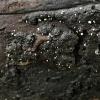
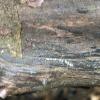
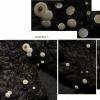
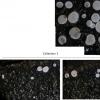
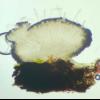
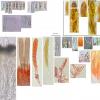
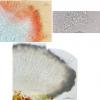
 Hymenium-0005.jpeg
Hymenium-0005.jpeg